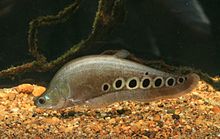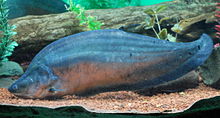Clown featherback
| Clown featherback | |
|---|---|

| |
| Sub-adult specimen | |
| Scientific classification | |
| Domain: | Eukaryota |
| Kingdom: | Animalia |
| Phylum: | Chordata |
| Class: | Actinopterygii |
| Order: | Osteoglossiformes |
| Family: | Notopteridae |
| Genus: | Chitala |
| Species: | C. ornata
|
| Binomial name | |
| Chitala ornata J. E. Gray,1831
| |
Theclown featherback(Chitala ornata), also known as theclown knifefishandspotted knifefish,is anocturnalspecies oftropicalfish with a long, knife-like body. Thisknifefishis native to freshwater habitats in Cambodia, China, Hong Kong, Laos, Macau, Thailand, and Vietnam,[2]but it has also beenintroducedto regions outside its native range.[1]It is one of the world's mostinvasive species.
It is often seen inaquacultureand the aquarium trade, where it is frequently confused withChitala chitala;the latter species is very rare in the aquarium trade.[3][4]The clown featherback reaches 1 m (3.3 ft) in length,[2]outgrowing all but the largest aquaria, yet it is popular.[3]
Distribution
[edit]This species is native to Cambodia, China, Hong Kong, Laos, Macau, Thailand, and Vietnam, where it is found in theMekong,Chao Phraya,andMeklongRiver basins.[2]It has also beenintroducedto regions outside its native range, including the Philippines, Indonesia, Myanmar, Singapore, Sri Lanka,MalaysiaandPalm Beach County,Florida,United States.[1][3]It has either spread to or was introduced toBroward County,Florida.[5]
Appearance
[edit]
The clown knifefish is very distinct, with normally silvery gray with a long, knife-like body (laterally compressed) and a long anal fin that gives it its common name. Mature fish normally have five to 10 (or even more) black spots ringed with white that usually decrease in size as the fish grows. These ocellated spots and the lack of faint stripes on the back separate it fromChitala chitala;a species with which it frequently has been confused.[3][6]Albinosandleucisticspecimens are seen with some frequency in the aquarium trade.[3]
Juveniles lack the spots, but are overall striped. Their long anal fins are used to make graceful forward and backward movements.
The clown knifefish grows to a fairly large size, up to 1 m (3.3 ft) and 5 kg (11 lb) in the wild.[2]It has twonasaltentaclesabove its large, toothed mouth. In the center of the body is a flag-likedorsal finand has noventral fins.
Behavior
[edit]They arenocturnaland usually cruise during thetwilighthours. They normally hunt livepreyand try any fish that fits into their mouths. Young clown knifefish usually school near water logs and plants for security, whereas more mature specimens usually become territorial and eventually become loners. These fish can also breathe air to survive in stagnant waters and little oxygen. The clown knifefish prefers water around neutralpHand temperatures ranging from 75 to 85 °F (24 to 29 °C). These fish usually are found in lakes, swamps, and river backwaters.
In the aquarium
[edit]Clown knifefish are sold as exotic fish in pet stores, but they grow much too large for the average home aquarium. These fish have periods of retreat, so aquaria that have caves, plants, or other hiding places are preferred. They are jumpers, so the lid should be kept tightly closed. Dim lighting may help lessen jumping. For the first few days, clown knifefish are shy and prone to hiding. As they grow larger, they tend to be quite the opposite.
Feeding
[edit]Clown knifefish are hearty eaters, and will take live foods such asfeeder fish,ghost shrimp,andblackworms.With time, they can be adapted to foods such as beefheart and will sometimes learn to accept commercial food pellets. They are mostly nocturnal, thus prefer feeding when the lights are off.
As food
[edit]The clown featherback is commonly seen in thecuisine of Thailandand other Southeast Asian countries. In Thailand, when deep-fried aspla krai thot krathiam(ปลากรายทอดกระเทียม), it is served with a spicy dipping sauce on the side made by mashing upcorianderroots,bird's eye chillies,and garlic, and mixing this withfish sauce,lime juice, and sugar. The clown featherback is also the main fish used in the production offish balls.
 |
 |
See also
[edit]References
[edit]- ^abcVidthayanon, C. (2012)."Chitala ornata".The IUCN Red List of Threatened Species.2012.IUCN:e.T181056A1693604.doi:10.2305/IUCN.UK.2012-1.RLTS.T181056A1693604.en.Retrieved13 January2018.
- ^abcdFroese, Rainer;Pauly, Daniel (eds.)."Chitala ornata".Fishbase.May 2014 version.
- ^abcdeSeriously Fish:Chitala ornata.Retrieved 24 May 2014
- ^Seriously Fish:Chitala chitala.Retrieved 24 May 2014
- ^"clown knifefish".EDDMapS.University of Georgia - Center for Invasive Species and Ecosystem Health.Retrieved5 August2020.
- ^Roberts, T.R. (1992).Systematic revision of the old world freshwater fish family Notopteridae.Ichthyol. Explor. Freshwat. 2(4):361-383.
- http://www.myfwc.com/WILDLIFEHABITATS/Nonnative_FW_ClownKnifefish.htmArchived2013-05-24 at theWayback Machine– accessed October 2006
- http://badmanstropicalfish.com/profiles/profile5.html- accessed October 2006
- http://www.aqualandpetsplus.com/Knife,%20Clown.htmArchived2013-08-10 at theWayback Machine
External links
[edit] Media related toChitala ornataat Wikimedia Commons
Media related toChitala ornataat Wikimedia Commons

